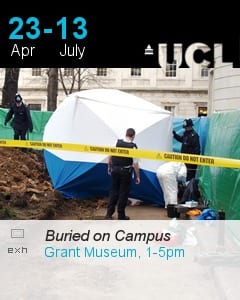Buried on Campus has opened
By Jack Ashby, on 24 April 2012
 Two years ago rumours spread quickly around UCL that builders working in the Main Quad on Gower Street had discovered human bones while they were digging an access trench. Lots of human bones. As would be expected, theories abound as to what the story behind such a discovery might be.
Two years ago rumours spread quickly around UCL that builders working in the Main Quad on Gower Street had discovered human bones while they were digging an access trench. Lots of human bones. As would be expected, theories abound as to what the story behind such a discovery might be.
The police were immediately involved, and they consulted UCL’s own expert forensic anatomist, Dr Wendy Birch, and established that no foul play had taken place, and the remains were not of police interest. Since then, Dr Birch and her colleagues have been researching the remains and trying to piece together (often literally – many of the bones were highly fragmented) what they are and why they were buried.
This is the topic of the Grant Museum’s new exhibition, Buried on Campus, co-curated by Wendy Birch and forensic anthropologist Christine King, our immediate Rockefeller Building neighbours in the UCL Anatomy Lab.
I can’t imagine what went through the construction workers’ minds when they made the discovery, but working with the experts to put this installation together certain things have left me quite surprised. The very concept that human material could have been buried like this is obviously shocking. In all, over 7000 bone fragments were discovered. It goes without saying that today this would never have happened, and indeed the 2004 Human Tissues Act outlaws it.
The whole topic of displaying human remains has to be considered carefully and handled sensitively. I think university museums, like the Grant, are particularly well placed for an exhibition like this – it’s really important that the research that’s being done does have a public forum and the university is being open about the topic. One of the questions we asked our visitors last term on a QRator iPad was “Should human and animal remains be treated any differently in museums like this?” and the majority of the responses were in favour of humans being displayed, with the sensible caveats of consent and sensitivity.
Some of the items in the exhibition are really quite amazing – there is a leg bone that has a tree root growing straight through it along its entire length, in the channel once occupied by marrow. The researchers have also reconstructed some of the bones from tiny fragments. There is a femur that they have rebuilt from 27 different elements found in the soil – it shows some incredible detective work.
The major answer to the “what is this collection?” question is that at least some of it appears to have once formed an anatomical teaching collection, much like those still used to train medics today. Many of the specimens show signs of dissection, some have writing on, and many show signs of disease.
The key element in the installation is a composite skeleton laid out in anatomical arrangement. It is built from many different individuals from elements that the team excavated. It displays many of the things that can be learnt from studying skeletons, showing how to determine sex and age, for example, from various parts of the body.
The exhibition runs until 13th July – do come in and take a look.
The full news article can be found here: http://www.ucl.ac.uk/news/news-articles/1204/120423-buried-on-campus
2 Responses to “Buried on Campus has opened”
- 1
-
2
Happy Second Birthday Grant Museum – A Year in Review | UCL UCL Museums & Collections Blog wrote on 15 March 2013:

[…] a difficult topic through an exhibition co-curated with forensic osteologists here at UCL – Buried on Campus. It explored the research that has been taking place on over 7000 human remains that were […]
 Close
Close


[…] [2] http://blogs.ucl.ac.uk/museums/2012/04/24/buried-on-campus-has-opened/ […]